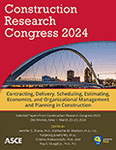Biggest Challenges Facing the Construction Industry
Publication: Construction Research Congress 2024
ABSTRACT
The construction industry is one of the main pillars of the economy. It plays a vital role in the country’s economy by generating employment, upgrading current infrastructure, and boosting overall economic activities. In the United States, the economic contribution of the construction sector to the gross domestic product is nearly 4%. Nevertheless, the construction industry has not reached the desirable levels of overall performance in terms of delivering projects on time and within budget while maintaining high levels of safety, quality, and sustainability. Consequently, it is critical to pinpoint the industry’s challenges to provide practical solutions. In this study, 25 experienced construction professionals were interviewed to understand better the emerging and persistent challenges of the construction industry. The study findings suggest that the most significant and pressing challenges facing the construction industry are (1) the shortage of skilled labor, (2) supply chain disruptions along with material and labor cost volatility especially after the COVID-19 pandemic, and (3) the slow integration, high cost, and maturity of new emerging technologies (e.g., 3D printing, virtual and augmented reality). The study findings will help industry leaders, governmental agencies, and construction researchers develop solutions that would improve the overall performance of the construction industry.
Get full access to this article
View all available purchase options and get full access to this chapter.
REFERENCES
Akponeware, A. O., and Z. A. Adamu. 2017. “Clash detection or clash avoidance? An investigation into coordination problems in 3D BIM.” Buildings, 7 (3): 75. MDPI.
Albattah, M. A., P. M. Goodrum, and T. R. Taylor. 2015. Demographic influences on construction craft shortages in the US and Canada.
Albert, A., M. R. Hallowell, B. Kleiner, A. Chen, and M. Golparvar-Fard. 2014. “Enhancing construction hazard recognition with high-fidelity augmented virtuality.” Journal of Construction Engineering and Management, 140 (7): 04014024. American Society of Civil Engineers.
Albert, A., B. Pandit, and Y. Patil. 2020. “Focus on the fatal-four: Implications for construction hazard recognition.” Safety Science, 128: 104774. https://doi.org/10.1016/j.ssci.2020.104774.
Alsharef, A., S. Banerjee, S. M. J. Uddin, A. Albert, and E. Jaselskis. 2021. “Early Impacts of the COVID-19 Pandemic on the U.S Construction Industry.” International Journal of Environmental Research and Public Health, 17 (21).
ASCE. 2021. “The American Society of Civil Engineers Report Card.” Accessed May 11, 2020. https://infrastructurereportcard.org/.
Bazeley, P., and K. Jackson. 2013. Qualitative Data Analysis with NVivo. SAGE publications limited.
Creswell, J. W., and C. N. Poth. 2016. Qualitative Inquiry and Research Design: Choosing Among Five Approaches. Sage publications.
Frey, H. C., W. Rasdorf, and P. Lewis. 2010. “Comprehensive field study of fuel use and emissions of nonroad diesel construction equipment.” Transportation Research Record, 2158 (1): 69–76. SAGE Publications Sage CA: Los Angeles, CA.
Galletta, A. 2013. Mastering the Semi-Structured Interview and Beyond: from Research Design to Analysis and Publication. NYU Press.
Gamil, Y., and I. Abdul Rahman. 2018. “Identification of Causes and Effects of Poor Communication in Construction Industry: A Theoretical Review.” Emerging Science Journal.
Hesna, Y., J. Sunaryati, and A. Hidayati. 2021. “COVID-19 pandemic impact: an identification of the cause of cost overrun in construction project.” E3S Web Conf., (L. Comfort, S. Saravanan, I. W. Sengara, and Fauzan, eds.), 331: 01014. https://doi.org/10.1051/e3sconf/202133101014.
Hussin, J. M., I. A. Rahman, and A. H. Memon. 2013. “The way forward in sustainable construction: issues and challenges.” International Journal of Advances in Applied Sciences, 2 (1): 15–24.
Jeelani, I., A. Albert, and J. A. Gambatese. 2017. “Why Do Construction Hazards Remain Unrecognized at the Work Interface?” J. Constr. Eng. Manage., 143 (5): 04016128. https://doi.org/10.1061/(ASCE)CO.1943-7862.0001274.
Jeelani, I., K. Han, and A. Albert. 2018. Scaling personalized safety training using automated feedback generation. 196–206.
Lewis, P., and W. Rasdorf. 2017. “Fuel Use and Pollutant Emissions Taxonomy for Heavy Duty Diesel Construction Equipment.” Journal of Management in Engineering, 33 (2). American Society of Civil Engineers. https://doi.org/10.1061/(ASCE)ME.1943-5479.0000484.
Namian, M., C. M. Zuluaga, and A. Albert. 2016. “Critical factors that impact construction workers’ hazard recognition performance.” Construction Research Congress 2016, 2762–2772.
National Safety Council. 2022. “Most Dangerous Industries.” Injury Facts. Accessed February 13, 2023. https://injuryfacts.nsc.org/work/industry-incidence-rates/most-dangerous-industries/.
Opoku, D.-G. J., S. Perera, R. Osei-Kyei, M. Rashidi, K. Bamdad, and T. Famakinwa. 2023. “Barriers to the Adoption of Digital Twin in the Construction Industry: A Literature Review.” Informatics, 10 (1). https://doi.org/10.3390/informatics10010014.
Rasoulkhani, K., A. Alsharef, S. Banerjee, S. Chowdhury, Q. Li, A. Mostafavi, J. Zhu, E. Jaselskis, and R. Stoa. 2020. “A Process Model for Regulatory Adaptation in the Construction Industry.” 1311–1320. American Society of Civil Engineers Reston, VA.
Saldaña, J. 2015. The Coding Manual for Qualitative Researchers. Sage.
Sandil, S., and R. Kumar. 2022. “Soil contamination from construction projects.” Ecological and Health Effects of Building Materials, 205–244. Springer.
Small Business Administration. 2020. “Paycheck Protection Program.” Paycheck Protection Program. Accessed August 17, 2020. https://www.sba.gov/funding-programs/loans/coronavirus-relief-options/paycheck-protection-program.
Stamatiadis, N., R. Sturgill, and K. Amiridis. 2017. “Benefits from constructability reviews.” Transportation research procedia, 25: 2889–2897. Elsevier.
Statista. 2020. “Value Added by the Construction Industry as a Share of Gross Domestic Product in the U.S. From 2007 To 2019.” Statista. Accessed December 2, 2020. https://www.statista.com/statistics/192049/value-added-by-us-construction-as-a-percentage-of-gdp-since-2007/.
Tizmaghz, Z., J. van Zyl, and T. Henning. 2022. “Consistent Classification System for Sewer Pipe Deterioration and Asset Management.” Journal of Water Resources Planning and Management, 148 (5): 04022011. American Society of Civil Engineers.
Welfare, K., F. Sherratt, and M. Hallowell. 2021. “Perceptions of Construction Work: Views to Consider to Improve Employee Recruitment and Retention.” Journal of Construction Engineering and Management, 147 (7): 04021053. American Society of Civil Engineers.
Information & Authors
Information
Published In
History
Published online: Mar 18, 2024
Authors
Metrics & Citations
Metrics
Citations
Download citation
If you have the appropriate software installed, you can download article citation data to the citation manager of your choice. Simply select your manager software from the list below and click Download.
